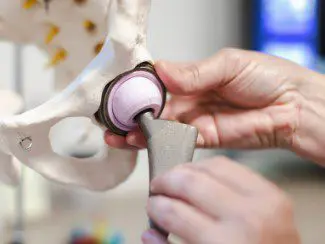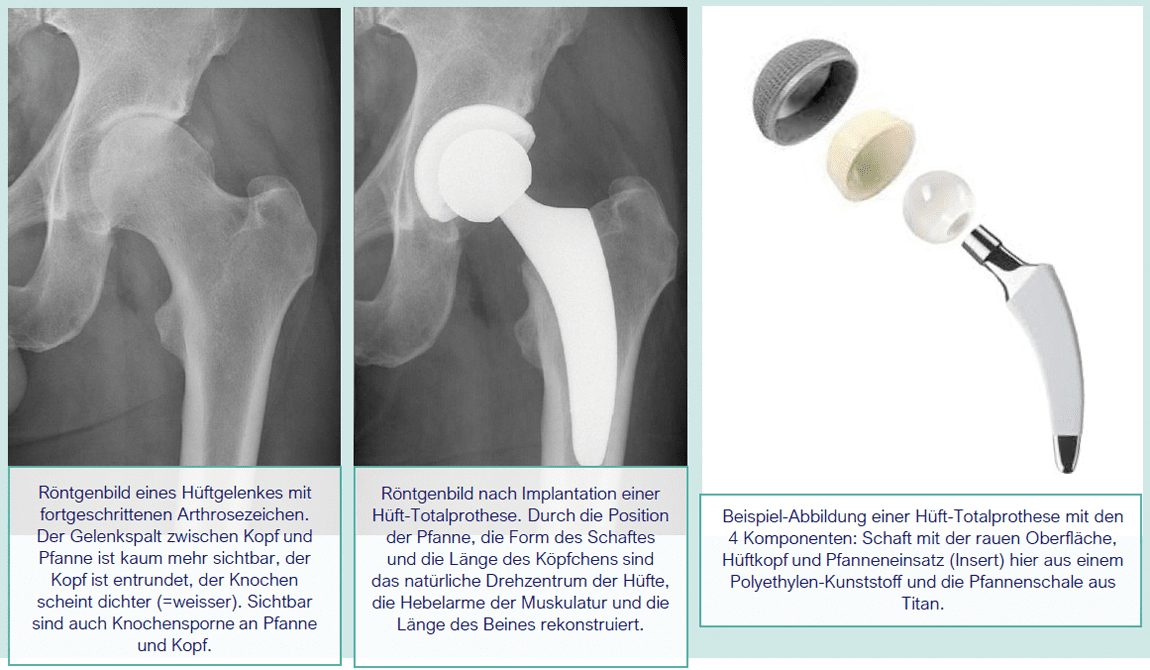
In a total hip prosthesis, both the worn socket and the femoral head are replaced with a new surface.
The aim is to reconstruct the original anatomy as accurately as possible with restoration of the leg length and lever arms (also known as offset). To achieve this precisely, we use robot-assisted surgical technology.
Principle of the hip prosthesis
The worn femoral head is removed during the operation. A stem is inserted into the bone on the femur and a spherical shell is inserted on the acetabulum side. Both components have a rough surface and are thus firmly clamped in the bone. Depending on the anatomy, different shapes and sizes of implants are available to ensure an optimal fit. The bone grows into the rough surface and thus ensures a long-term firm prosthesis fit.
Whenever possible, we use so-called short-shaft implants. They can be implanted more gently on the muscles and enable faster rehabilitation and a more natural joint feeling. Alternatively, the components can be cemented, as explained in more detail later. This is decided depending on the bone quality.
The hip prosthesis also consists of the bearing surfaces, through which the actual joint movement takes place. A so-called insert is inserted into the cup component and a head is attached to the cone of the hip stem. There are different materials to choose from, which will be discussed in more detail later. The leg length can be adjusted in 3 mm increments using the size or length of the head. At articon, this is measured during the operation using computer navigation and thus individually reconstructed.

Cementless or cemented hip prosthesis?
According to current studies, there is no difference in terms of function or durability between cemented and cementless prostheses. Nevertheless, the majority of prostheses used in Switzerland are cementless. The biological connection between bone and socket is seen as advantageous, especially if a prosthesis needs to be replaced at some point. Accordingly, we at articon also predominantly use cementless prostheses. The cementless hip stems and cup shells are made of coated titanium. Titanium has very good tissue compatibility and the bone grows within a few weeks. This guarantees a very long durability due to the biological connection to the implant.
However, if the bone quality is impaired (osteoporosis), cementing the socket can be advantageous because bone cracks are less likely to occur when the prosthesis is inserted. This is decided during the operation. Incidentally, osteoporosis as such does not affect the ingrowth or durability of a cementless prosthesis. Cementation can also be useful for older patients and patients at risk of falling, as the risk of a bone fracture after the operation is reduced.
Optimal sliding pairing of a hip prosthesis
articon only uses denture heads made of modern, fracture-resistant ceramics. These have the best wear properties and are well tolerated. For younger and active patients, we generally use 32 mm head diameters, as these show the lowest wear values. In older patients with limited musculature, a larger head, possibly consisting of two movable components, can provide additional protection against dislocation of the hip joint and is then used by us.
Two different materials are available for the cup insert: Ceramic like the femoral head or – highly cross-linked polyethylene, i.e. a plastic.
In the Swiss prosthesis register, both materials have practically the same survival times. Laboratory tests have also shown only minimal differences in the wear behavior of the modern materials, so that both combinations can be regarded as practically equivalent in everyday clinical practice. When using the robot-assisted surgical method, we always use a highly cross-linked polyethylene in combination with a ceramic head.